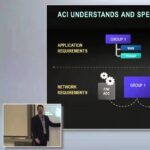|
|

Joe Onisick presented for Cisco Datacenter at NFD8 |

This video is part of the appearance, “Cisco Presents at Networking Field Day 8“. It was recorded as part of Networking Field Day 8 at 08:00-10:00 on September 11, 2014.
Watch on YouTube
Watch on Vimeo
Joe Onisick, Principal Engineer at Cisco, introduces the concept of Application Centric Infrastructure (ACI) in this Tech Field Day presentation. He begins by clarifying that ACI is a form of Software-Defined Networking (SDN), addressing initial confusion about whether ACI fits within the SDN framework. Onisick emphasizes that ACI is designed to modernize network operations, making them more efficient and aligned with current technological advancements. He highlights three major technical shifts in the data center: the rapid increase in compute power, the evolving landscape of virtualization, and the changing data traffic patterns from North-South to East-West. These shifts necessitate higher bandwidth and more efficient network designs, such as spine-leaf architectures, to handle the increased data flow and avoid the limitations of traditional oversubscribed hardware.
Onisick delves into the complexities of modern networks, comparing network engineers to MacGyver for their ability to use protocols like IP and spanning tree to solve problems. He points out that while storage and compute have evolved rapidly, networking has lagged, leading to complex environments that SDN aims to simplify. ACI addresses the siloed nature of data center teams, particularly the disconnect between application and network teams. Onisick introduces the concept of an application network profile, a logical description of the end-to-end connectivity and policy requirements for an application. This profile allows for the automatic translation of application requirements into network configurations, simplifying the deployment process and ensuring that policies are consistently applied across different environments.
The presentation also covers the practical aspects of implementing ACI, including its compatibility with existing network designs and its cost-effectiveness. Onisick explains that ACI can operate in two modes: ACI mode and NXOS mode, the latter being a traditional Nexus operating system mode that fits into existing network designs. He emphasizes that ACI is designed to scale linearly, making it suitable for both small and large deployments. Security is a key focus, with ACI offering built-in security features that act like a stateless firewall, ensuring that no traffic is allowed without explicit policy. This approach simplifies compliance and auditing, as policies can be centrally managed and applied across both physical and virtual devices. Onisick concludes by discussing the cost advantages of Cisco’s hardware, including their BiDi optics, which allow for 40 gigabit connections using existing 10 gigabit fiber infrastructure, further reducing the overall cost of network upgrades.
Personnel: Joe Onisick










